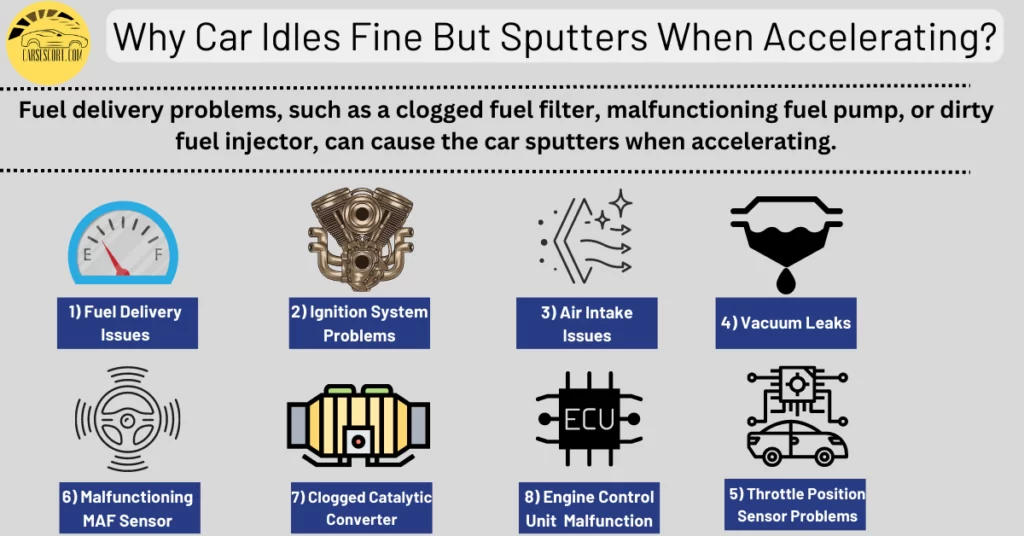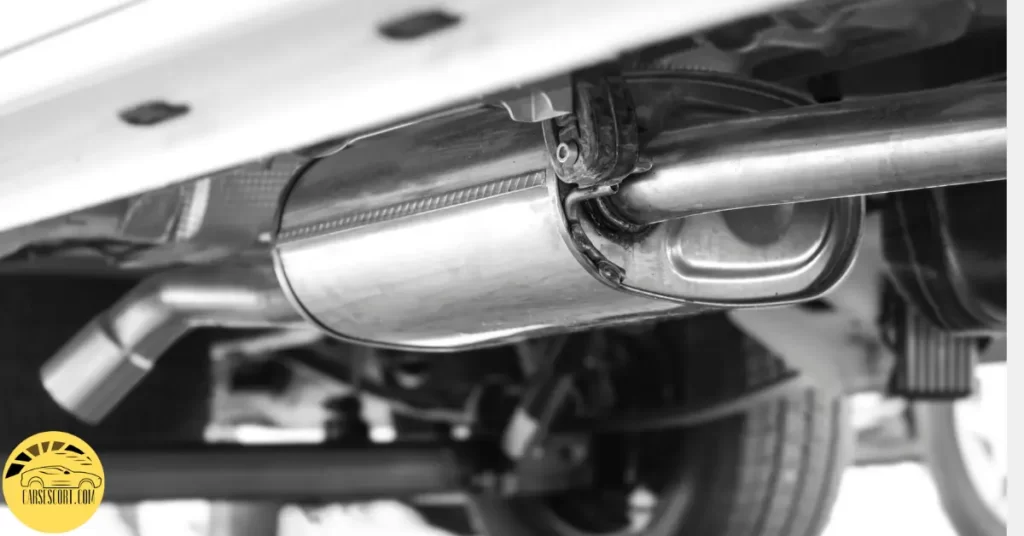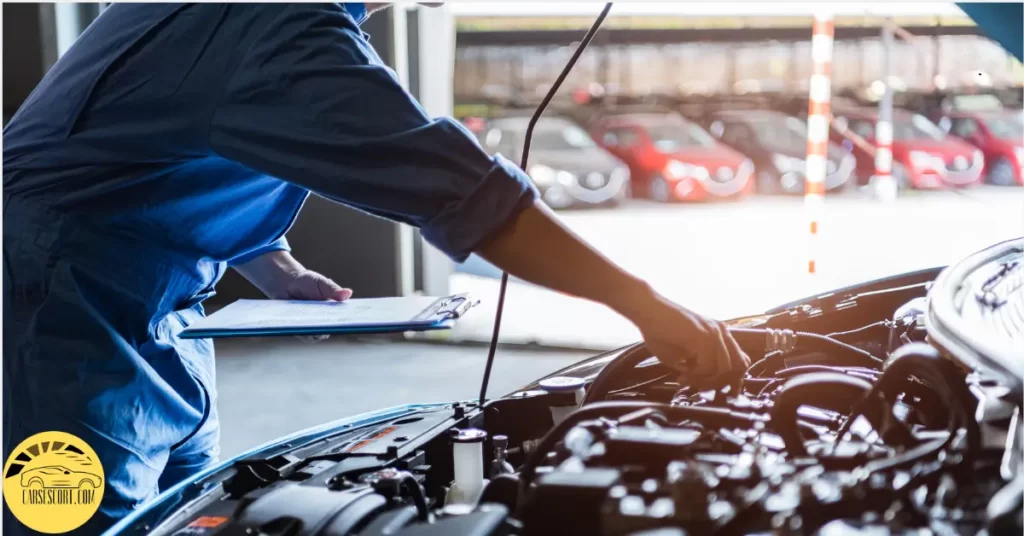The perplexing issue of a car idling fine but sputtering when accelerating can have various underlying causes, ranging from minor issues to more complex mechanical problems.
- Fuel delivery problems, such as a clogged fuel filter, malfunctioning fuel pump, or dirty fuel injector, can cause the car sputters when accelerating.
- Issues with the ignition system, such as worn-out spark plugs or faulty ignition components, can also lead to sputtering during acceleration.
- A restricted or dirty air filter, vacuum leaks, problematic throttle position sensor (TPS), malfunctioning mass airflow sensor (MAF), or a malfunctioning engine control unit (ECU) can all contribute to the problem.
Is Car Sputtering a Serious Problem?
Yes, car sputtering can be a severe problem that should not be ignored. Sputtering refers to a situation where the engine runs unevenly, causing intermittent jerking or shaking motions. It is often accompanied by a rough idle, lack of power, and sometimes stalling.
However, not all the time does the sputtering engine indicate a severe issue. Minor issues such as blocked exhaust pipes, fuel contamination, faulty spark plugs, and loose wire can make your engine sputter.
Why Car Idles Fine But Sputters When Accelerating?
If your car idles fine but sputters when accelerating, several causes could contribute to this situation. Some of these issues may be minor and can be addressed with minimal effort, even by yourself.
However, certain problems may be more complex and require the assistance of a professional mechanic.

1) Fuel Delivery Issues
When experiencing sputtering during acceleration, it is often indicative of problems with car fuel delivery or the fuel system as a whole. Several potential culprits could be causing this issue, such as a clogged fuel filter, a malfunctioning fuel pump, or dirty fuel injectors.
A faulty or failing fuel pump may be unable to provide the necessary amount of fuel, causing engine to sputter, especially during increased demand, such as acceleration.
A clogged engine’s fuel injectors and filter can impede fuel injection process, resulting in insufficient fuel gauge. Over time, dirt, debris, and contaminants can accumulate in the filter, restricting the passage of fuel and leading to engine performance problems include engine sputters.
Dirty fuel injectors can also contribute to fuel delivery problems. Fuel injectors spray a fine fuel mist into the engine’s combustion chambers.
Over time, they can become clogged or develop deposits, affecting fuel atomization and distribution. This can result in uneven fuel delivery to the cylinders, leading to sputtering when accelerating and decreased overall engine performance.
2) Ignition System Problems
Faulty ignition components, including spark plugs, ignition coils, or ignition wires, can disrupt the combustion process and result in sputtering or hesitation in the engine’s performance.

When the spark plugs are worn or fouled, they struggle to ignite the fuel mixture consistently, causing sputtering during acceleration.
A faulty ignition coil can result in uneven or weak sparks, leading to misfires and sputtering during acceleration. If the ignition coil is malfunctioning, it may need to be diagnosed and replaced to restore proper spark generation and ensure smooth engine performance.
Ignition wires, known as spark plug wires or high-tension cables, transmit the electrical current from the ignition coil to the plugs. Over time, these wires can degrade, develop cracks, or lose their insulation, leading to electrical arcing or weak sparks.
Faulty ignition wires and bad spark plugs can cause misfires and sputtering car under load or during acceleration. Inspecting and replacing worn or damaged ignition wires can help maintain consistent spark delivery and prevent sputtering.
3) Air Intake Issues
When encountering sputtering during acceleration, it is essential to consider the condition of the air intake system. A restricted or dirty air filter can disrupt the crucial air-fuel mixture, leading to engine sputtering or hesitation.
The air filter serves as a barrier, preventing dirt, dust, and other contamination from entering the engine. Over time, the air filter can become blocked and dirty, restricting the airflow to the engine.
As a result, the air-fuel mixture may become imbalanced, leading to sputtering during acceleration.
Other air intake system components can also contribute to sputtering problems. For example, the air intake ducts and hoses should be inspected for any signs of damage or leaks.
Cracks or lose connections in the intake system can allow unmetered air to enter the engine, disrupting the air-fuel mixture and causing sputtering or hesitation.
4) Vacuum Leaks
When experiencing sputtering during acceleration, it is crucial to investigate the possibility of vacuum leaks. Vacuum leak issue occurs when there is an unintended opening or damage in the vacuum system, leading to an imbalance in the air-fuel mixture and causing engine sputtering.
The vacuum system plays a vital role in operating various components, such as the brake booster, PCV (Positive Crankcase Ventilation) valve, and emission control system.
It relies on a network of hoses and gaskets to create a vacuum that regulates the airflow and controls various engine functions.
If any of these hoses are damaged, loose, or disconnected, unmetered air can enter the system, causing an imbalance in the air-fuel mixture and sputtering during acceleration.
5) Throttle Position Sensor (TPS) Problems

The Throttle Position Sensor (TPS) is a critical component that monitors the position of the throttle in the engine. It provides feedback to the engine control unit (ECU) about the throttle’s position, allowing it to adjust the fuel delivery and ignition timing accordingly.
However, if the TPS malfunctions or sends incorrect signals, it can disrupt the engine’s performance and lead to sputtering during acceleration.
The TPS consists of a sensor that measures the angle of the throttle plate and a connector that transmits the data to the ECU. Over time, the TPS can wear out or develop internal faults, resulting in erratic readings or complete failure.
When the TPS malfunctions, it may send incorrect signals to the ECU, leading to improper fuel and ignition adjustments. Your car may idle fine but can cause engine sputtering, hesitation, or even stalling during acceleration.
6) Malfunctioning MAF Sensor
The Mass Airflow Sensor (MAF) measures the air entering the vehicle engine and provides this information to the engine control unit (ECU). The ECU utilizes the data from the MAF to determine the correct amount of fuel to inject for achieving the optimal air-fuel mixture.
However, if the MAF becomes dirty or malfunctions, it can disrupt the air-fuel ratio, leading to sputtering during acceleration.
Over time, the MAF can accumulate dirt, oil, and other contaminants from the intake air. Dirty or damaged mass airflow sensors can affect the MAF’s ability to accurately measure the incoming air volume, leading to an incorrect calculation of the fuel mixture.
A dirty MAF may cause the engine to receive too much or too little fuel, resulting in car engine sputtering, hesitation, or a loss of power during acceleration.
7) Clogged Catalytic Converter
A clogged catalytic converter is a common culprit behind engine sputtering. The catalytic converter is crucial in reducing harmful emissions by converting toxic gases into less harmful substances.
However, over time, the catalytic converter can become clogged or restricted, impeding the exhaust flow and leading to sputtering during acceleration.
Clogged and faulty catalytic converter , it restricts the flow of exhaust gases, which can disrupt the engine’s performance.
Due to failing catalytic converter, the engine may experience difficulty maintaining consistent power delivery, leading to sputtering, hesitation, or a loss of acceleration.

8) Engine Control Unit (ECU) Malfunction
The Engine Control Unit (ECU) is a vital component that controls and manages various engine functions, including fuel injection, ignition timing, and emissions control.
If the ECU is not operating correctly or experiencing a malfunction, it can lead to car sputtering during acceleration and overall engine performance issues.
The ECU relies on data from various sensors throughout the engine to make real-time adjustments for optimal performance. If the ECU receives inaccurate or inconsistent data from these sensors, it may misinterpret the engine’s operating conditions and disrupt the air-fuel mixture or ignition timing, resulting in sputtering.
Various factors, including electrical issues, software glitches, or hardware failures, can cause a malfunctioning ECU.
What Does An Engine Sputter Feel Like?
An engine sputter can be described as a rough, uneven, or jerky sensation experienced while driving or idling. It often feels like the engine is struggling or hesitating, producing a series of irregular or intermittent bursts of power.
The vehicle may vibrate or shake, and there might be a noticeable loss of acceleration or overall performance.
How to fix the sputters in your vehicle?
Check for a Check Engine Light (CEL)
If the Check Engine Light is illuminated on your dashboard, the vehicle’s onboard diagnostic system has detected a problem. Use an OBD-II scanner to retrieve the error codes and identify the specific issue causing the sputters.
Inspect the spark plugs
Worn-out or fouled spark plugs can cause misfires and sputtering. Inspect the spark plug for signs of damage, such as worn electrodes or heavy carbon deposits. Replace any faulty plugs with new ones recommended by your vehicle’s manufacturer.
Examine the ignition coils
Faulty ignition coils can lead to sputtering. Inspect the ignition coils for any signs of damage, such as cracks or carbon tracking. Replace any damaged ignition coils.
Check the fuel system
A clogged fuel filter or a failing fuel pump can result in fuel delivery issues, leading to sputtering. Replace a clogged fuel filter and test the fuel pressure to ensure it meets the manufacturer’s specifications. If the fuel pump is faulty, it may need to be replaced.
Inspect the air intake system
A restricted airflow due to a clogged air filter or a malfunctioning mass airflow sensor (MAF) can cause sputtering. Clean or replace the air filter and inspect the MAF sensor for dirt or debris. Clean the MAF sensor carefully using an appropriate cleaner if necessary.
Check for vacuum leaks
Vacuum leaks can disrupt the air-fuel mixture and cause sputtering. Inspect all vacuum hoses and connections for any cracks or loose fittings. Replace or repair any damaged hoses or connections.
Test the fuel injectors
Dirty or clogged fuel injectors can cause uneven fuel distribution and sputtering. Consider using a fuel injector cleaner additive to clean the injectors. If the problem persists, professional cleaning or replacement may be necessary.
Scan for other potential issues
If the sputtering persists after checking the above components, there might be other underlying problems, such as a faulty sensor or an issue with the engine control module (ECM). It is recommended to consult a qualified mechanic or take your vehicle to a trusted repair shop for further diagnosis.

Is Sputtering A misfire?
Yes, sputtering is often associated with engine misfires. A misfire occurs when the fuel mixture in one or more cylinders fails to ignite properly, interrupting the combustion process.
This can result in sputtering, rough idling, reduced power, and potentially even engine stalling. Misfires can have various causes, including spark plug issues, fuel delivery problems, ignition system faults, or sensor malfunctions.
Why Is My Car Sputtering After I Changed The Spark Plugs?
If your car is sputtering after changing the spark plugs, there could be a few reasons for this issue. First, it’s possible that the new spark plugs were not properly installed or the gap between the spark plug electrodes was not set correctly. This can affect the ignition process and lead to sputtering.
Another possibility is that the replacement plugs are low-quality or incompatible with your vehicle’s specifications. Using the recommended plugs for your car’s make and model is essential.
Why Is My Car Sputtering At Low RPM?
Sputtering at low RPM (revolutions per minute) can indicate various underlying issues. One common cause is a problem with the fuel system, such as a clogged fuel filter or a weak fuel pump. These issues can restrict fuel flow to the engine, resulting in incomplete combustion and sputtering.
Another potential cause could be a malfunctioning idle control valve regulating air intake during idle conditions. If the valve is faulty, it can disrupt the proper air-fuel mixture and cause sputtering at low RPM.
Also issues with the ignition system, such as worn spark plugs or a failing ignition coil, can lead to sputtering at low engine speeds.
FAQ
Why does my car sputter and lose power while driving?
Possible reasons for a car sputtering and losing power while driving include issues with the fuel system (e.g., clogged fuel filter or weak fuel pump), ignition system (e.g., faulty spark plugs or ignition coil), or engine sensors (e.g., oxygen sensor or mass airflow sensor).
Why does my car stutter when I press the gas?
When a car stutters or hesitates when the gas pedal is pressed, it can be caused by various factors, such as a clogged fuel injector, a malfunctioning throttle position sensor, a vacuum leak, or an issue with the air intake system.
Can bad fuel cause sputtering?
Yes, bad fuel can cause sputtering in a car. Contaminated or low-quality fuel can lead to poor combustion, sputtering, rough idling, or a loss of power. Water or other impurities in the fuel can also disrupt the combustion process and cause sputtering.
Can spark plugs make your car sputter?
Yes, faulty or worn-out spark plugs can cause a car to sputter. If the spark plug is not firing correctly, it can result in incomplete combustion, leading to sputtering, misfires, and decreased engine performance.
Can dirty oil cause sputtering?
Dirty oil itself is unlikely to cause sputtering directly. However, dirty oil can contribute to engine problems that may result in sputtering. Over time, dirty oil can lead to increased friction, inadequate lubrication, and damage to engine components, affecting overall engine performance and potentially causing sputtering.
Affiliate Disclosure: Cars Escort is a participant in the Amazon Services LLC Associates Program. As an Amazon Associate, we earn from qualifying purchases made through affiliate links on our site. Read Our Disclaimer .

